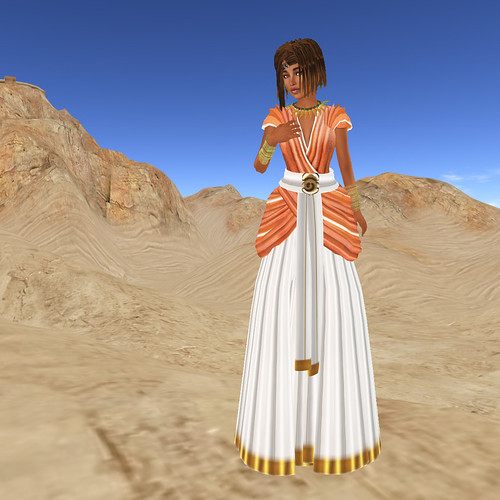When you come across an ancient Egyptian woman in Heritage Key Virtual, you will notice that there is one very popular style of fashion: a pale belted kilt or kalasiris (simple dress) brightened with gold and lapis collars, bracelets and belts, and finished off with a chic slash of kohl to each eye. Its an iconic image that was universal for ladies of early Egypt and, as with most areas of ancient Egyptian life, there was a reason behind every facet of the look.
The types and colours of fabrics were very limited in the earlier dynasties. The linen flax that women picked and spun and wove into fabric was very difficult to dye, and until dying was introduced by the people of Caanan and Syria in the era of the New Kingdom, the main color of fabric was a natural off-white. In addition, there were only three fabrics to choose from: wool (used predominately by the lower classes and considered unclean), undyed linen of varying quality, and in the later dynasties, dyed linen and imported silk for the rich.
Weve got White, and Weve got White White
People of the upper classes wore their linen bleached to a paler white to symbolize purity. Men wore it in gathered kilts of varying lengths that were either simply or elaborately pleated, and women in a Kalasiris that descended from either above or below the breasts down to the ankles. The kalasiris was held up by shoulder straps, and often gathered with colorful woven or metal belts to give the garment shape. It was sewn from a rectangular linen sheet with a head opening in the center, folded in half, with the lower parts stitched together. Sometimes beads were used to embellish these dresses, and the breasts were bared or covered as fashion dictated.
Despite the plainness of the fabric, people would enliven their garments in a variety of ways. A small circular cape was often worn over the shoulders that was dyed, beaded, or painted – a bright splash of color over the plainness of the linen Kalasiris.
Added Bling
Jewellery was also worn, but never simply as adornment. It was an indication of wealth or status, religiously symbolic, and always equated with nefer, or the ideal of beauty. Jewellery was worn by rich and poor, men and women alike, and was often in the form of amulets of protection around the neck or ring seals indicating rank and position. Jewelry was made from many things, including natural objects such as shells and ivory, and man-made ones such as copper or gold or faience or glass. Every part of society owned at least a few items of jewelry.
Makeup was not considered a frivolity in Ancient Egypt. Instead, it was used by men and women for symbolic and practical purposes as well as for beauty. Dark kohl powder made from a crushed mineral was applied around the eyes. The practical purpose was to help protect the eyes from the glare of the desert sun, and symbolically to protect from evil and disease.
Sometimes this liner was heightened by a green powder on the eyelid. A rusty-colored paste was smeared high on the cheekbones and also used as lip-liner, giving the distinctive dark-lipped look that has been often depicted on tomb walls.
Hair was an elaborate work of art, with many options for braiding natural hair, weaving in extensions, or shaving the head entirely and wearing finely-made human-hair wigs. Wigs and extensions were adorned with beads and curls and braids, with women’s a little longer, but men’s more elaborate in style.
In the later dynasties a process of color-safe dying developed which enabled red, yellow and blue linens to be created, allowing for a more elaborate look. Purple was difficult. It was made by weaving red and blue threads closely together, or by immersing linen in a three-step dying process. This was why purple was the color of royalty; it was said that Queen Cleopatra‘s ships had purple sails. Imagine the wealth and status that whole sheafs of purple would connote to a culture of pale cloth!

